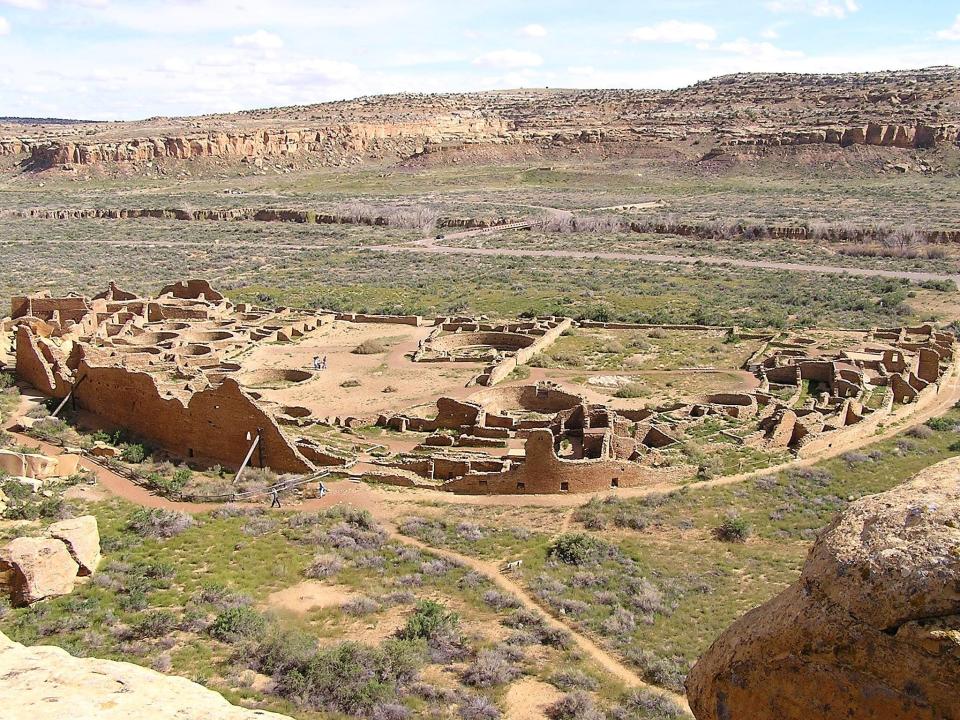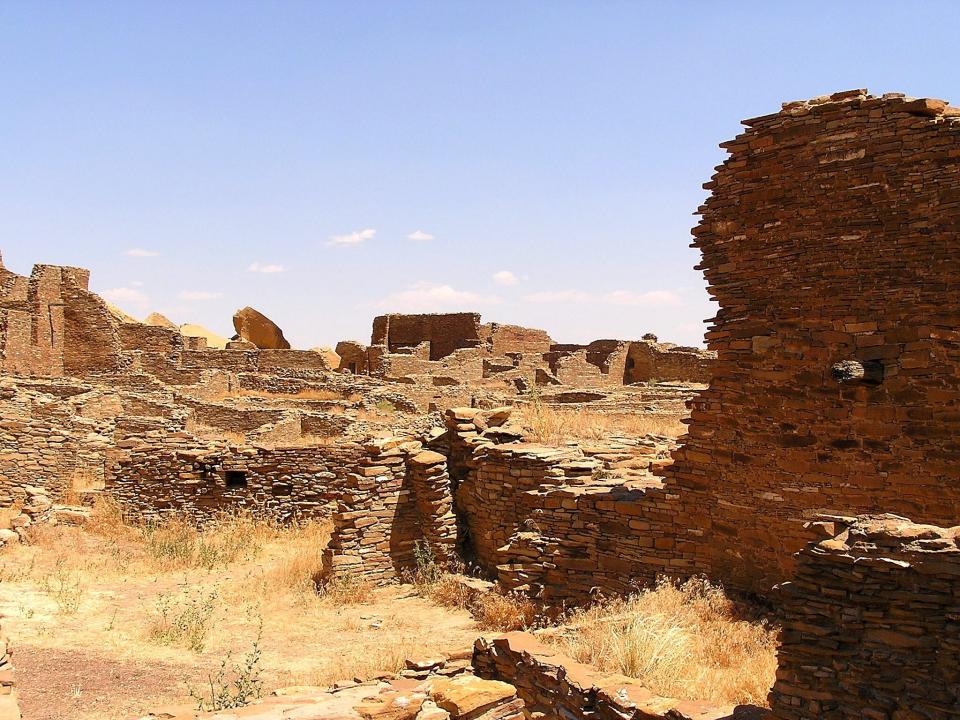Criticism, praise directed at Chaco 10-mile buffer order issued by interior secretary
- Oops!Something went wrong.Please try again later.
FARMINGTON — A June 2 decision by Secretary of the Interior Deb Haaland to withdraw public lands within a 10-mile radius of Chaco Culture National Historic Park from new oil and gas leasing and mining claims for 20 years has drawn both positive and negative reactions from various groups affected by the order.
The order applies only to public lands and the federal mineral estate, not to minerals owned by private, state or tribal entities, according to a news release announcing the order. Nor does the order apply to existing leases, meaning additional wells could continue to be drilled on those leases, and Navajo Nation allotees can continue to lease their minerals.
The order makes good on a pledge by President Joe Biden to protect the greater Chaco area during a November 2021 White House Tribal Nations Summit.
“Efforts to protect the Chaco landscape have been ongoing for decades, as Tribal communities have raised concerns about the impacts that new development would have on areas of deep cultural connection,” Haaland stated in the news release. “Today marks an important step in fulfilling President Biden’s commitments to Indian Country by protecting Chaco Canyon, a sacred place that holds deep meaning for the Indigenous peoples whose ancestors have called this place home since time immemorial. I value and appreciate the many Tribal leaders, elected officials and stakeholders who have persisted in their work to conserve this special area.”

While some Native groups applauded the move, the order drew a strong rebuke from the Navajo Nation government, which issued a news release urging Biden and Haaland to reconsider the decision, characterizing it as a “breach of trust” between federal officials and the tribe.
“The Secretary’s action undermines our sovereignty and self-determination,” President Buu Nygren stated in the release, noting the decision was issued just a day after his tribe commemorated Treaty Day, which recognizes the start of the government-to-government relationship between the Navajo Nation and the United States. “Despite my concerns and denunciation, the Department of Interior has move(d) forward which is highly disappointing. Secretary Haaland’s decision impacts Navajo allottees but also disregards the tribe’s choice to lease lands for economic development.”
Nygren went on to say the move jeopardizes the Navajo Nation’s future economic opportunities while placing approximately 5,600 Navajo allottees in “dire financial constraints.”
Crystaline Curley, the speaker of the Navajo Nation Council, maintained in a statement that there was no significant consultation by the federal government with tribal nations before the announcement was made.
“The current resolution and position of the Navajo Nation supports no land withdrawal,” Curley stated in the release. “In the past, the Navajo Nation attempted to compromise by proposing a five-mile buffer as opposed to the 10-mile. The Biden Administration has undermined the position of the Navajo Nation with today’s action and impacted the livelihood of thousands of Navajo allotment owners and their families. While we explore our options, we remain open to discussing a path toward compromise.”
Conversely, an official from the Native Land Institute — an Acoma-based organization dedicated to advancing economic, environmental and social justice for indigenous communities across the Southwest and beyond, according to its website — hailed the order, calling it a significant step toward protecting sacred Indigenous lands and preserving cultural heritage.
“As an organization deeply rooted in the protection and conservation of our ancestral lands, we have long advocated for the preservation of sacred sites and their surrounding ecosystems,” Keegan King, the founder and CEO of the Native Land Institute, stated in a news release. “This decision aligns with our mission to safeguard the cultural and natural heritage of Indigenous peoples in New Mexico. We firmly believe that by preserving our sacred sites, we are not only honoring our ancestors but also fostering a sustainable future for all.”
The Navajo Nation’s criticism of the order was echoed by officials of at least two oil and gas production organizations in New Mexico, the Independent Petroleum Association of New Mexico and the New Mexico Oil and Gas Association.

Jim Winchester, executive director of the former, characterized the 10-mile buffer zone “arbitrary” and said the order was “discompassionate” to the Native allottees it will affect. He claimed they will lose out on an estimated $194 million in potential royalties, according to figures cited by the Western Energy Alliance, and described the move as a capitulation to environmental groups that want to ban oil and gas drilling.
Winchester also said his organization has supported the Navajo Nation’s proposed five-mile buffer around the park and described Haaland’s order as highly unethical, claiming she has a conflict of interest because of her daughter’s political activism.
A news release issued by the New Mexico Oil and Gas Association took particular aim at the claim by federal officials that Navajo allottees would be free to continue to exercise their mineral rights and lease their lands, pointing out that many of those plots are “checkerboarded” among federal mineral rights territories. The practical effect of the order, the association argues, will be to render those allotments unleaseable.
“The DOI continues to ignore that modern techniques consist of horizontal rather than vertical drilling for mineral development,” the news release states. “Without the ability to include federal minerals in drilling blocks, the Navajo Allotments will not be able to be economically developed. These lands consist of remote uninhabited areas that lack roads and any kind of infrastructure such as water, power lines or pipelines. It is impossible to access the Navajo allotments without crossing federal minerals, which requires, at the very least, the issuance of BLM Rights of Way.”
Kathleen Sgamma, the president of the Western Energy Alliance, the organization that issued the $194 million lost royalties estimate cited by Winchester, said Haaland’s order will threaten the livelihoods of 5,500 Navajos who live near the park. She said Haaland failed to consider the Navajo Nation’s proposed five-mile buffer before making her decision, claiming that move leaves the order legally vulnerable.
“She completely ignored the democratic resolutions of the sovereign Navajo Nation whose lands surround the park and put the interest of her tribe, based a hundred miles away, and obstructionist groups first,” Sgamma said of Haaland, who is a member of the Pueblo of Laguna.
An environmental group, the Greater Chaco Coalition, which represents a variety of organization, was lukewarm toward Haaland’s order. The coalition found fault with the order for a different reason, arguing it doesn’t go far enough.
The coalition continues to call for an end to federal fossil fuel leasing and development across the entire greater Chaco landscape, as well as the country.
“By Interior’s own estimates, the mineral withdrawal around Chaco Park will have minimal impact on oil and gas drilling,” the coalition stated in a news release. “Meanwhile, Diné communities living outside the 10-mile buffer face growing threats from oil and gas pollution.”
Miya King-Flaherty, an organizing representative for the Sierra Club’s Rio Grande Chapter, one of the organizations included in the Greater Chaco Coalition, said the order creating the 10-mile buffer around Chaco is an important first step. But she said more must be done to safeguard the region and its communities.
“Now is the time for the Bureau of Land Management to restore balance in the region, beyond a 10-mile buffer around the park, and to phase out and end new oil and gas drilling that continues to harm public health and safety and air and water quality,” she stated in a news release.
Robyn Jackson, executive director Diné C.A.R.E., another member of the coalition, also called on the Biden administration to do more to protect the area.
“The toll of oil and gas drilling has led to harmful community health impacts and serious climate impacts, as evidenced by the methane plume documented in the region,” she stated in the press release. “We cannot ignore the devastating impacts that oil and gas have on our climate, region, culture, living communities and future generations.”
Ally Beasley, a staff attorney for the Western Environmental Law Center, which has offices scattered throughout the Mountain West region, said Chaco’s culturally important areas extend far beyond the park’s borders and need to be protected, as well.
“More than 90% of Greater Chaco is already either industrialized by oil and gas extraction or promised to industry for more drilling in the future, even as we recognized this activity’s impacts on the area’s communities and the climate,” she stated in a news release. “We will continue to put for an end to oil and gas drilling on all public land in the U.S. so we may all enjoy a health, livable future in which our leaders prioritize environmental justice.”
In early May, all five members of New Mexico’s congressional delegation — Ben Ray Luján and Martin Heinrich in the Senate, and Teresa Leger Fernández, Melanie Stansbury and Gabe Vasquez in the House, all Democrats — reintroduced the Chaco Cultural Heritage Area Protection Act, which is designed to protect the park and the greater landscape from oil and gas leasing and development. The bill would establish a 10-mile buffer around the park on a permanent basis.
Similar measures were introduced in Congress in 2018 and 2019 but were not adopted.
Mike Easterling can be reached at 505-564-4610 or measterling@daily-times.com.
Support local journalism with a digital subscription: http://bit.ly/2I6TU0e.
This article originally appeared on Farmington Daily Times: Feds say order won't impact Navajo allottees, but tribe disagrees

